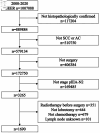Role of Postoperative Radiotherapy on High-Risk Stage pIIIA-N2 Non-Small Cell Lung Cancer Patients After Complete Resection and Adjuvant Chemotherapy: A Retrospective Cohort Study
- PMID: 38545478
- PMCID: PMC10965260
- DOI: 10.14740/wjon1832
Role of Postoperative Radiotherapy on High-Risk Stage pIIIA-N2 Non-Small Cell Lung Cancer Patients After Complete Resection and Adjuvant Chemotherapy: A Retrospective Cohort Study
Abstract
Background: The aim of the study was to assess the effectiveness of postoperative radiotherapy in high-risk patients with stage pIIIA-N2 non-small cell lung cancer (NSCLC) following complete resection and adjuvant chemotherapy.
Methods: Data from NSCLC patients within the Surveillance, Epidemiology, and End Results (SEER) database were analyzed. The study examined the association between lymph node ratio (LNR) and both cancer-specific survival (CSS) and overall survival (OS) using restricted cubic spline curves. Patients were categorized into high- and low-risk groups based on established LNR cut-off values, and survival outcomes were compared between those receiving postoperative radiotherapy and those who did not within the high-risk group.
Results: The study included 1,690 patients. An LNR threshold of 0.29 was identified for both CSS and OS. Patients with an LNR ≥ 0.29 demonstrated significantly worse CSS (hazard ratio (HR) = 1.56, 95% confidence interval (CI): 1.37 - 1.78; P < 0.001) and OS (HR = 1.44, 95% CI: 1.28 - 1.62; P < 0.001) compared to those with an LNR < 0.29. In the high-risk group (LNR ≥ 0.29), postoperative radiotherapy did not significantly affect CSS (HR = 0.98, 95% CI: 0.82 - 1.17; P = 0.809) or OS (HR = 0.95, 95% CI: 0.81 - 1.11; P = 0.533).
Conclusions: LNR is a significant prognostic factor in patients with stage pIIIA-N2 NSCLC post complete resection and adjuvant chemotherapy. A higher LNR (≥ 0.29) is associated with poorer CSS and OS. However, postoperative radiotherapy does not confer survival benefits in these high-risk patients. Our findings suggest that postoperative radiotherapy should not be routinely performed in this subgroup. Further research is required to explore effective treatment strategies for these patients.
Keywords: Lymph node ratio; Non-small cell lung cancer; Postoperative radiotherapy; Stage pIIIA-N2.
Copyright 2024, Chen et al.
Conflict of interest statement
The authors declare no conflict of interest.
Figures






Similar articles
-
Advances in adjuvant therapy for operable N2 non-small cell lung cancer: a narrative review.Front Oncol. 2025 Jan 21;14:1523743. doi: 10.3389/fonc.2024.1523743. eCollection 2024. Front Oncol. 2025. PMID: 39906659 Free PMC article. Review.
-
Postoperative radiotherapy for stage pIIIA-N2 non-small cell lung cancer patients undergoing sublobar resection: A retrospective cohort study.Medicine (Baltimore). 2025 Feb 7;104(6):e41462. doi: 10.1097/MD.0000000000041462. Medicine (Baltimore). 2025. PMID: 39928784 Free PMC article.
-
Positive lymph node ratio predicts adverse prognosis for patients with lymph nodes metastatic hypopharyngeal squamous cell carcinoma after primary surgery.Transl Cancer Res. 2022 Mar;11(3):463-474. doi: 10.21037/tcr-21-1740. Transl Cancer Res. 2022. PMID: 35402181 Free PMC article.
-
Recommended optimal range for the count of examined lymph nodes and lymph node ratio for postoperative adjuvant radiotherapy in patients with pN2 non-small cell lung cancer: a multicenter retrospective cohort investigation.J Thorac Dis. 2025 Feb 28;17(2):784-795. doi: 10.21037/jtd-24-1573. Epub 2025 Feb 27. J Thorac Dis. 2025. PMID: 40083515 Free PMC article.
-
Postoperative radiotherapy in pIIIA-N2 non-small cell lung cancer after complete resection and adjuvant chemotherapy: A meta-analysis.Medicine (Baltimore). 2022 Jul 15;101(28):e29550. doi: 10.1097/MD.0000000000029550. Medicine (Baltimore). 2022. PMID: 35839025 Free PMC article.
Cited by
-
Advances in adjuvant therapy for operable N2 non-small cell lung cancer: a narrative review.Front Oncol. 2025 Jan 21;14:1523743. doi: 10.3389/fonc.2024.1523743. eCollection 2024. Front Oncol. 2025. PMID: 39906659 Free PMC article. Review.
-
Postoperative radiotherapy for stage pIIIA-N2 non-small cell lung cancer patients undergoing sublobar resection: A retrospective cohort study.Medicine (Baltimore). 2025 Feb 7;104(6):e41462. doi: 10.1097/MD.0000000000041462. Medicine (Baltimore). 2025. PMID: 39928784 Free PMC article.
-
Prognostic value of lymph node ratio in patients with non-small cell lung cancer: a systematic review and meta-analysis.Front Oncol. 2025 Jul 1;15:1601575. doi: 10.3389/fonc.2025.1601575. eCollection 2025. Front Oncol. 2025. PMID: 40666101 Free PMC article.
References
-
- Douillard JY, Rosell R, De Lena M, Carpagnano F, Ramlau R, Gonzales-Larriba JL, Grodzki T. et al. Adjuvant vinorelbine plus cisplatin versus observation in patients with completely resected stage IB-IIIA non-small-cell lung cancer (Adjuvant Navelbine International Trialist Association [ANITA]): a randomised controlled trial. Lancet Oncol. 2006;7(9):719–727. doi: 10.1016/S1470-2045(06)70804-X. - DOI - PubMed
-
- Arriagada R, Bergman B, Dunant A, Le Chevalier T, Pignon JP, Vansteenkiste J, International Adjuvant Lung Cancer Trial Collaborative G. Cisplatin-based adjuvant chemotherapy in patients with completely resected non-small-cell lung cancer. N Engl J Med. 2004;350(4):351–360. doi: 10.1056/NEJMoa031644. - DOI - PubMed
LinkOut - more resources
Full Text Sources
